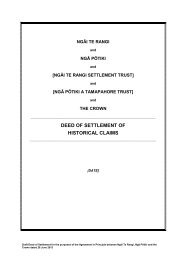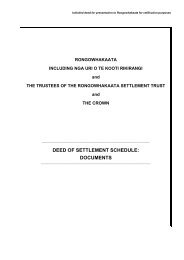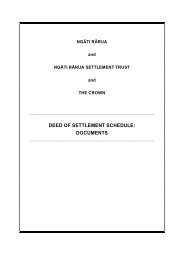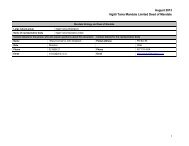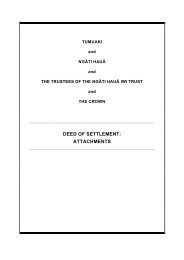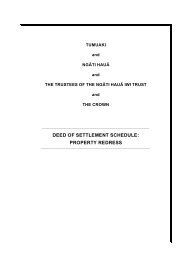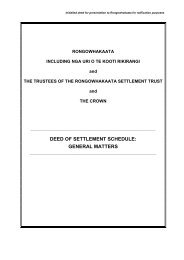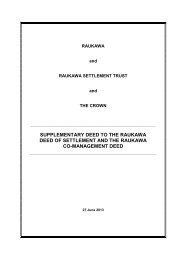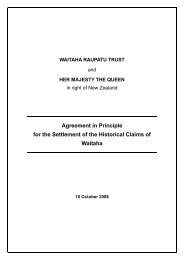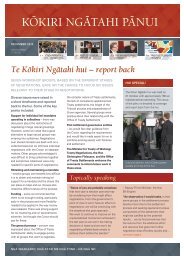Ngati Haua Deed of Settlement - Terabyte Interactive
Ngati Haua Deed of Settlement - Terabyte Interactive
Ngati Haua Deed of Settlement - Terabyte Interactive
Create successful ePaper yourself
Turn your PDF publications into a flip-book with our unique Google optimized e-Paper software.
NGĀTI HAUĀ DEED OF SETTLEMENT2: HISTORICAL ACCOUNTCourt was necessary for Māori to sell or legally lease land or to use it as security toenable development <strong>of</strong> the land.2.92 There was no consultation with Ngāti Hauā or any other Māori concerning the NativeLands Acts prior to their being enacted and Māori were not represented in the NewZealand Parliament at the time. The legislation did not reflect Ngāti Hauā’s customarytenure system, which accommodated complex and fluid relationships and land andresource usages. The Native Land Court awarded titles to named individuals, whowere also free to apply for investigations <strong>of</strong> title without reference to other right-holders.Ngāti Hauā considers this undermined the communal basis <strong>of</strong> their customary landtenure and the ability <strong>of</strong> the iwi and its hapū to manage their lands in a considered way .In 1885, 49 members <strong>of</strong> Ngāti Hauā petitioned Parliament asking that “the Native LandCourt should be abolished as every Native who consents to his land being adjudicatedupon by this Court obtains no benefit therefrom”.NGĀTI HAUĀ ENGAGEMENT WITH THE COURT2.93 In March 1866 the Native Land Court sat for the first time in Hamilton. It investigatedthe titles to some blocks outside <strong>of</strong> the confiscated area claimed by members <strong>of</strong> NgātiHauā. Wiremu Tamehana appeared at the hearing on behalf <strong>of</strong> Ngāti Hauā. Heexerted his leadership role in a new context, accommodating the interests <strong>of</strong> other hapūand iwi in accordance with Ngāti Hauā tikanga. However, Wiremu Tamehana did notattend the Court again after the first hearing.2.94 Besides the early hearings at Hamilton, many <strong>of</strong> the cases involving lands claimed byNgāti Hauā were held at Cambridge. Most supporters <strong>of</strong> the Kīngitanga, including anumber <strong>of</strong> other Ngāti Hauā, opposed the Court’s jurisdiction over their lands andrefused to participate in its hearings. In November 1868, Wiremu Tamehana’s sonTupu Taingakawa travelled to Cambridge to protest in the name <strong>of</strong> the Kīngitangaagainst the Court dealing with certain Waikato lands. However, his protest was ignoredand the Court continued.2.95 Members <strong>of</strong> Ngāti Hauā who attended the Court were required to pay fees to the Courtitself, along with survey costs and other expenses. The costs could be high,particularly when cases were contested. In 1871, participating in hearings for TeAroha, Ngāti Hauā were reported to have incurred expenses in excess <strong>of</strong> £575.2.96 Some <strong>of</strong> the costs incurred by Ngāti Hauā at Native Land Court hearings were for foodand accommodation, since it was common for the Court to be convened in Europeantownships such as Cambridge that were <strong>of</strong>ten some distance from the lands underinvestigation or from their usual places <strong>of</strong> residence.TEN-OWNER RULE2.97 Between 1865 and 1873, the native land legislation provided for the Native Land Courtto limit the number <strong>of</strong> owners named on a title to ten or fewer individuals. Those sonamed on the certificates <strong>of</strong> title were legally able to act as absolute owners if theychose to do so, and could alienate lands without reference to other members <strong>of</strong> theirhapū or iwi. By 1867 the Native Land Court had applied the ten-owner rule to a number<strong>of</strong> large blocks in which Ngāti Hauā interests were recognised, including Hinuera,Wharetangata, Matamata, Puketutu, Te Pae o Turawaru, and Te Au o Waikato.2.98 Section 17 <strong>of</strong> the Native Lands Act 1867 amended the ten-owner rule. This providedfor additional right holders to be named on the back <strong>of</strong> the certificates <strong>of</strong> title, indicatingthe trust relationship between the legal owners and other members <strong>of</strong> their community.22



